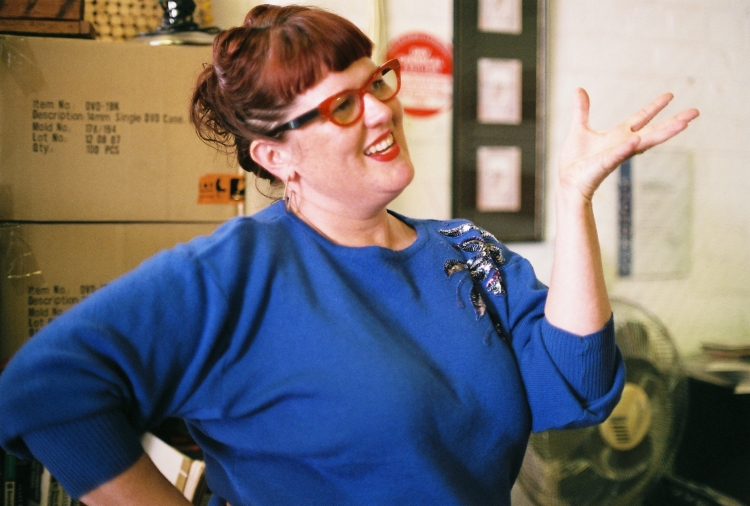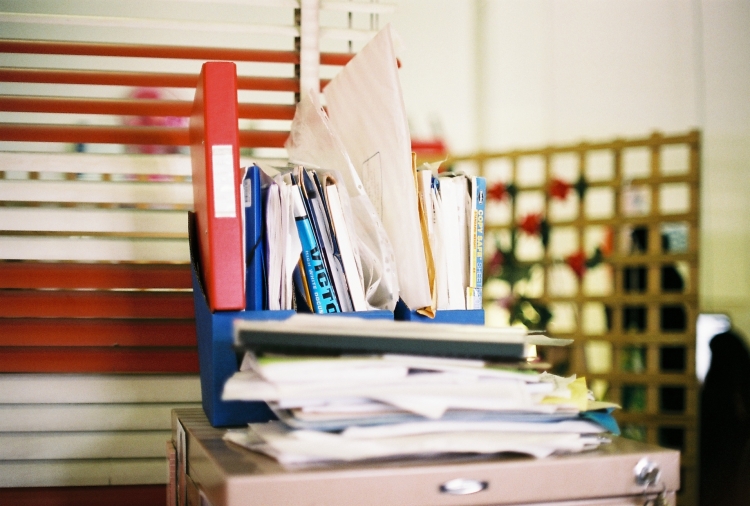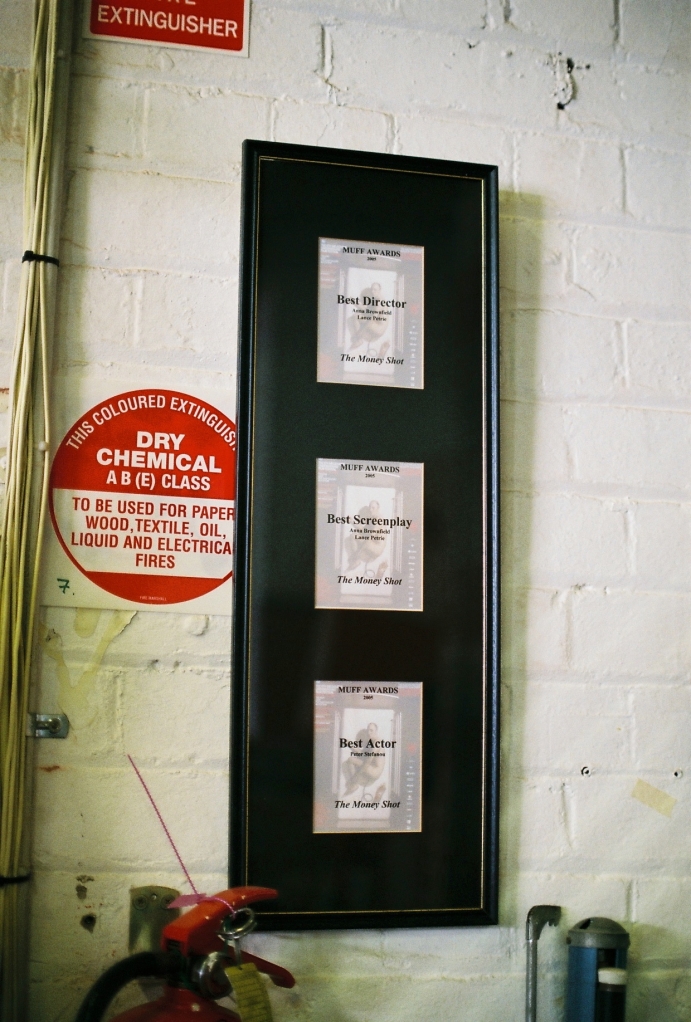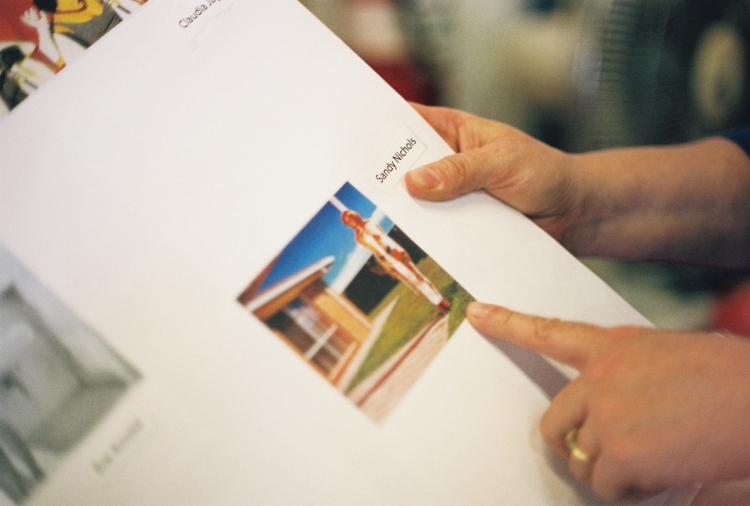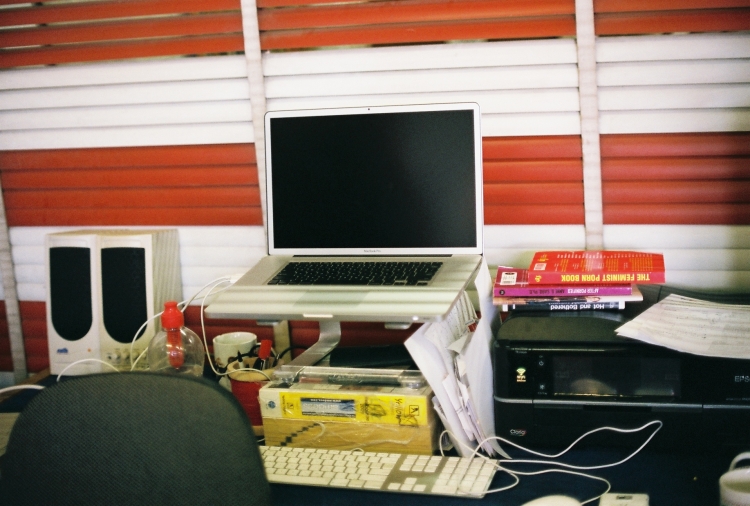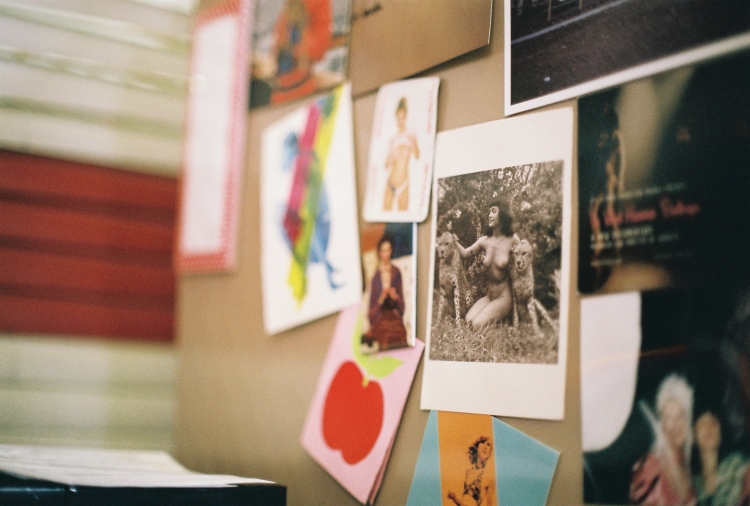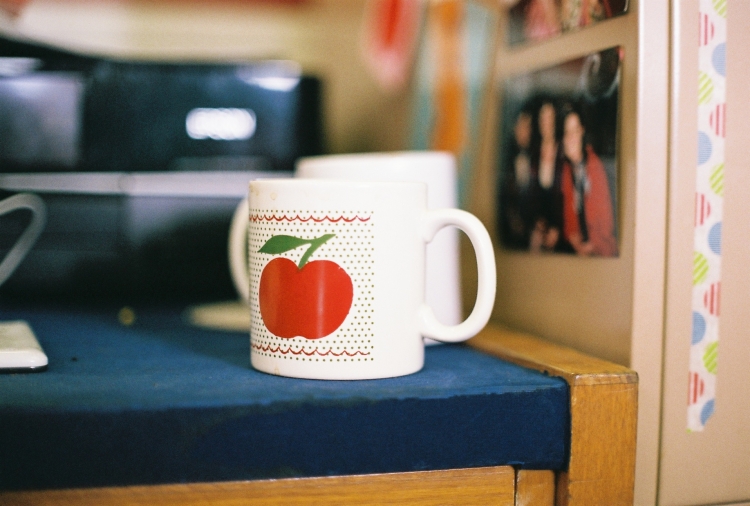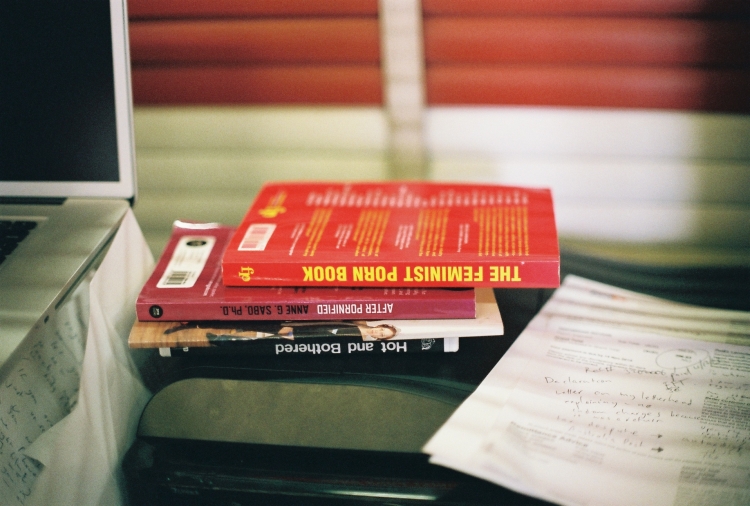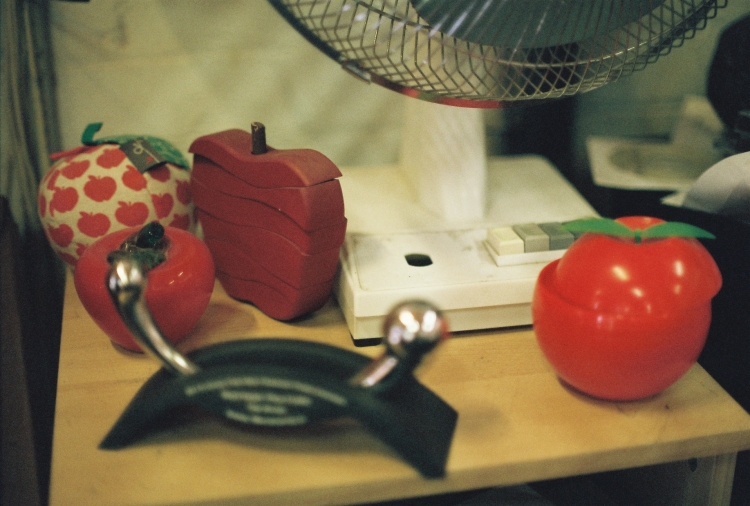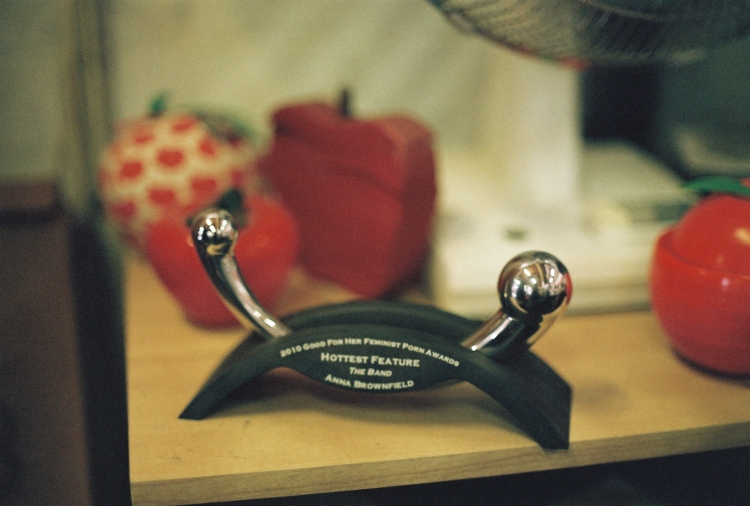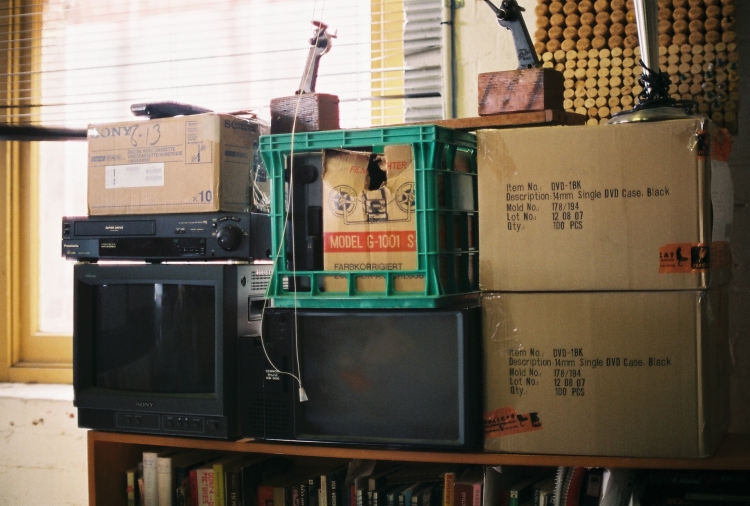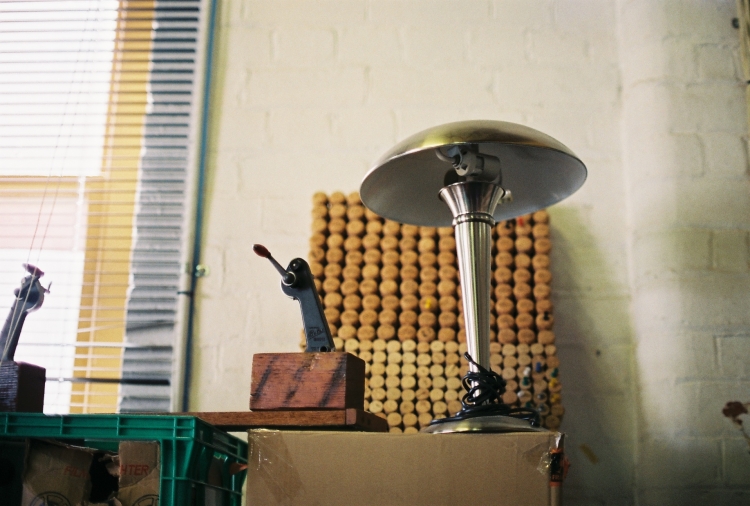It is hard to know what to expect from a visit with Mother Porn.
While she may not immediately reach for the title herself (in a humble rejection of its reverent rather than lowbrow tones) speaking with the documentarian, and award-winning feminist erotic filmmaker Anna Brownfield, she seems an apt matriarch for the growing porn community in Australia. When she welcomes me into her studio she is dressed in a cozy blue angora jumper; her auburn hair is swept back into an unassuming up-do; she wears square, red-framed glasses and just a slick of red lipstick—typical (though stylish) mumsy garb.
While she is quite literally a mother (to a toddler son) too, she has her fingers in all manner of incongruous pies. A pile of knitting, a porn documentary, and an explicit feature each cool side-by-side on the proverbial windowsill that is her creative output.
She is not someone who bends easily to any one definition of her work, instead picking and choosing what best suits at the time. She can be an erotic filmmaker in the morning, a pornographer at night and a creator of explicit features anytime in between. Her choice of terms is solely dependent on whom she is talking to: “and what I think their preconceived ideas might be”.
Despite this flexibility the term “pornographer” is something which she has slowly grown confident with over time. For a serious filmmaker, it’s hard to escape the connotations of that word.
When she first started to tell people she was making porn they often carried assumptions about it based on the mainstream style they were familiar with. They thought of porn as having “no story lines” and “low production values”.
This led her to then branding her work ‘chick porn’: (“but then “everyone thought I was going to make lesbian films, for a heterosexual market”). These pre-conceptions about the genre indicated to Anna a gaping void in the pornographic genre; for narrative-driven features, dealing with nuanced, lifelike erotic situations between fully fleshed-out characters. Appealing to women as well as men. Oddly, a shocking concept at the time.
Before entering the industry, she received a more conventional film education, studying Media Arts at RMIT. She has always had a strong interest in sexuality, “particularly female sexuality and its representation on screen,” and with “experimental” aesthetics, two elements which transferred readily into her erotic work. At that time, in a case of art imitating life, “I made a no-budget feature called Money Shot (2002) about a girl, who, after she graduates from film school and she can’t get a job decides to make porn.”
At that time she had been approached by a company in Queensland to produce erotica, but they wanted, she said, the generic “everyday sort of stuff.” This didn’t appeal to her, as she already had a strong sense of her own identity as a filmmaker and what she wanted to make (“I wanted to use my real name, I wanted to have control of it and be able to try to produce something in the way that I wanted to.”)
After that, she says. “It seemed to be a natural progression from doing simulated sex to doing real sex.”
The logistics of her filmmaking are dictated largely by the red tape surrounding all sex industries in Australia. While Victoria is one of the three states with regulated (and hence legal) prostitution (along with Queensland and NSW), it is still illegal to film and produce pornography here. This means that her production takes place in Australia’s surprising porn-mecca-by-default, the Australian Capital Territory (“the only place to legally make porn in Australia.”)
Her films can be distributed online to Australia as well; “as long as they are posted through an overseas website.” She has since sold her overseas rights to a distributor in the United States, where they are marketed as erotic art films; “they don’t actually market it as porn.” She also has a distributor in France, and one in Germany. However, due to the growing popularity of online viewing and the decline of DVD, she is currently in talks with a few different sites for Video on Demand or Direct Digital Download distribution, (those “who market towards more alternative, or more, do I use the term? woman-friendly porn.”)
Anna produced her first full-length feature, The Band, starting in 2006. She released it in 2009. The film was a rollicking tale, detailing the ins-and-outs of a punk band, and featuring all the associated sex-drugs-and-rock-and-roll— including seventeen minutes of explicit sexual content.
Around the time of shooting, the porn industry in Australia was only beginning to emerge, and the film industry within that was virtually non-existent. Small, web-based companies, ‘I Shot Myself,” and ‘Abby Winters,’ which primarily hosted DIY photographic content were the only real players at that time, Anna says.
When recruiting performers for the feature she approached these companies. She also used word-of-mouth and the street press. Social media, which is now integral to her process, “was just starting to take off.”
Wishing to depart from the kind of conventional choreography performed by “homogenous” body types in mainstream pornography, she also “didn’t necessarily want people who were born performers.”
“We wanted it to be a more natural representation that wasn’t formulaic like most mainstream or commercial porn, that we are sort of inundated with from America and Europe.”
Of course, some acting ability would be required to allow for filmic verisimilitude (“so they needed to be able to do some of that to a certain degree”) but she was more interested in sourcing performers from outside of the conventional parameters of porn aesthetics. “I was looking for diversity in terms of body types in terms of femininity and masculinity.”
Oftentimes the performers she found were interested in participating as part of a “sexual or erotic adventure or journey;” a kind of transgressive process of self-discovery achieved through flouting social conventions. (“It was a way for them to explore and express their sexuality in a way that wasn’t pre-defined by any other type of film, I think they saw it as a way to further explore their sexuality and sex for themselves.”)
A lot of her performers also saw their participation as a form of political resistance- in an affront to conventional mores of sexuality. “A lot of them thought of it as a way to thumb their nose to society and to say, well, look what I’m doing.”
As such, she employed strong, autonomous individuals whose input was fundamental to the development of her film.
As such, Anna Brownfield sees her films as a product of collaboration rather than the singular vision of an auteur.
Her process involves a lot of outsourcing, particularly in areas outside of her expertise, such as sound design and art direction. She engages experts who can provide input and suggestions she wouldn’t have “otherwise considered”.
When she was making her erotic feature The Band, she was often astounded and excited at the breadth of solutions her production designer was able to formulate.
“I’m just like wow, this is amazing, how could you have thought of all those sorts of things?”
“That for me is really exciting, to see how they interpret what you’ve got and what they can bring to it as well,” she says, acknowledging, “That’s a huge part of the process, acknowledging these people and their skills and giving them the freedom to put their mark on the piece.”
This openness is also key to workshopping the dramatic performances in her films. Often the script will be moderated and the direction of the scenes will change through interventions made in rehearsal.
“There’s one scene in The Band, which was this argument scene, where it was very much written like, he says this, she says this big chunk, and then he says that, and that’s the end of the scene, but the way they ended up working through it through workshopping and rehearsal was that it became a lot more rapid-fire between the two of them, like two people argue.”
This is, she says, one of the aspects of collaboration that really excites her.“While it’s my idea, I like for them to put their own stamp of creativity on it as well.”
While the rehearsals often involve a lot of directional input from her performers, due to the strictly predefined narrative structure of her films the actual filming is much more controlled. One of the defining characteristics of her sex scenes is that they need to be representative of the particular experience of sex they are portraying, which is determined through the dramatic logic of the film. “If it was a one-night-stand, or if it was between two people who knew each other for a while, or if it was the first time, or they’d only had sex several times, we wanted it to be representative of that.”
This veritae approach paradoxically increased the level of directorial control required.
“I know there is very much a school of thought where they just set up two camera or just have one camera roaming and just let the actors go, and there is an element of that,” she says, though she admits, “because it was so story-driven I really wanted the sex to be representative.”
Any alterations which occur to the scene happen before the final explicit version is shot, during rehearsal, or what she refers to, tongue-in-cheek, as the ‘dry-hump run.’
“Generally what we do is have a little bit of a chat with the actors beforehand, before we shoot the scene, to work out what we’re roughly going to do. Then we generally do what I call the ‘dry-hump run’, where we run through the scene, but without it actually being nude, without there being explicit sex going on. So this would also mean that we could shoot things for an R-rated version as well, and then we would go through it as an explicit scene.”
One aspect of her creative process which she is continuing to evaluate is this modicum of control. According to Anna, there is a great deal of debate occurring about this aspect in the Australian porn community; “about what is real and what isn’t.”
“There’s some people who would say, maybe you’re not making it realistic, or it’s artificial, because you are controlling them more. If you let the performers go and do what they wanted to do, would that be a more authentic representation?”
“Because I’m in a controlled environment and being directed and being told what to wear, is the arousal and the potential orgasm I’m experiencing any more authentic than if the person who’s making it just says ‘do what you want?'”
While she hasn’t watched mainstream pornography for a long time, her first forays into the genre where very much reaction to the limited content she found available. Films at the time were “really quite violent, aggressive, there was lots of choking, lots of slapping, lots of skull-fucking stuff going on.”
She objected not just to the toxicity of the violence portrayed but also to to the highly conventional and tired paradigms reinforced repeatedly in these films.
“It’s porn-by-numbers, it’s a very restrictive number of positions they use because it’s so they can get the camera in there and get their close-ups, whereas we’re not being so dictated by that.”
She also objected to the bizarre and highly unrealistic sexual congress depicted in the films.
“In a lot of mainstream commercial porn you’ll see a lot of stuff where a person who’s all: ‘I’m a virgin, I’m a virgin,’ is suddenly having sex like someone who’s had lots of experience.”
“Two people walk into a room and suddenly they’ve got no clothes on and they’re having sex.There’s none of that sort of build-up of what happened beforehand: how did they get undressed? did they undress each other? did they just strip off?—I find those little things a lot more interesting and as titillating and as exciting and interesting as the actual sexual itself.”
The reliance on stock cinematographic conventions, such as the “cum-shot- where every scene has to end with some kind of cum-shot on something” was also odd and limiting to her. While she was openminded to the kinds of sexuality depicted in these films (“maybe that could be something you’re into sometimes”) she could not accept these as a nuanced and multifarious depiction of “the way sex is in the real world.” She wanted her work to be antithetical to this; a thoughtful and nuanced representation of the realities of sex.
Her work, encompassing documentary, video art, along with pornographic/erotic features, while multifarious in their incarnations, are motivated by the same concern. “Politics drives everything,” she says.
“My work is politically driven, even the documentary I made called Making It Handmade! (2010), about indie craft.”
When she first told people about her idea, she was met with unequivocal bemusement: “You’ve gone from making porn or erotica to making something about craft?”
The project was based out of her dual motivations for creating; passion and politics. She had been interested in craft mediums for her whole life, and when she quit smoking a few years ago she took up knitting again.
“I thought, I’ll Google some knitting patterns, and all of a sudden this whole world of this indie craft movement that was happening online opened up to me.”
“I thought, this is cool, this is awesome, this is amazing; all these women are taking traditional craft and subverting it in this really amazing way.”
Initially, the project was supposed to look at this subversive craft revival as a global movement, featuring interviews with key players from all around the world. Due to a lack of funding the documentary’s focus became more localised.
“ So I shot local women instead, which I think was just as interesting and exciting as shooting these international people.”
What also appealed to her when she was making the film were the “sexy elements” to this movement.
One of her interview subjects was feminist crafter, Casey Jenkins, whose vaginal knitting has made her a viral internet star.
“At that time she was making these cunt fling-ups, these cunts [made] using craft techniques and flinging them over power lines around Melbourne.”
She was interested in her work as an act of “normalising female genitals, and Jenkins’ assertion “that cunt was not a dirty word.” She was interested in her unveiling and de-stigmatising the anatomy of the vagina, “rather than it being seen as something to be hidden or something not to be discussed.”
Highlighting craft styles which has been made historically invisible through the system of patriarchy was a fundamentally political move. “I was telling female stories, especially with craft, it’s something that was in the home, it’s something women were doing.”A
A related idea, of allowing women the agency to control their own image drives a lot of her pornographic work. In a time where female artists are increasingly distancing themselves from being called feminists, Anna embraces the term.
“I think that that’s a leftover thing in terms of what people saw feminists as being in the eighties, there’s the very man-hating separatist form of feminism that was also anti-sex that sort took over.”
“It’s still the dirty ‘F’ word, there’s still that connotation,” she says. Not one to back away from divisive terms, she instead embraces it, infusing her distinct ethos into everything she creates.
Hence, her films always consciously revolve around the empowerment of female figures.
“A lot of the time women are the focus of my films, they’re very strong, they’re very much in control of the sex they’re having and of their sexuality.”
Ideally, she wanted her films to operate as a space where her performers were not “dictated by what society is telling you, in terms of being a woman and how your sexuality works.”
She also thinks that it is important to explore a “diversity of sexuality and sexual fantasies” in her films: (“being a woman nowadays, we have a certain amount of fluidity in terms of our sexualities, and that’s one thing that I sort of strive with in my films- to show the fluidity of sexuality rather than it being very much controlled and confined”.)
“It’s about having strong women who are in control of the type of sex that they’re having, whether they’re in a dominant situation or a submissive situation; that they are in control of how they’re represented,” she says.
She is also very interested in exploring the female gaze, and for embracing female fantasy through her films. This is articulated both through the sexual agency of her female characters and also through objectifying the masculine form.
“In mainstream porn the camera’s very focused on the woman and her body,” she says. “The man becomes kind of a prop- once they’re having sex he’s mainly just genitals.”
“In a lot of my films I have really objectified men and put a female gaze upon their bodies as well,” she says. “I mean I used to call it reverse-sexism but I don’t know if it’s really that appropriate anymore,” she laughs.
‘A lot of people have said that the men in The Band, are all dickheads and doofuses, and it’s something that I tend to do, I tend to write men’s roles a bit in that way, maybe as I mature I might start writing more gratifying and full roles,’ she says.
This kind of ‘reverse sexism,’ is founded in a sense of frustration about what she sees as a tradition of belittling women through their visual representation.
“I think we spend so much time as women being ridiculed, or being belittled and I think it’s important to turn the tables and have a little laugh at men, and be judgmental about them. “
She is also interested in challenging the way in which masculinity is coded through art.
“I remember one of my friends saying, penises are so scary, but we’re never exposed to a lot of images of [them],” she says.
“If we look at art in general, it’s very difficult to find male nudes, you can find a lot of female nudity, whether it’s in sculpture or photography.”
Rather than ignoring the male body, or seeing it as a mere vessel for the facilitation of male fantasy and pleasure, she is interested in exploring its value, both aesthetically, and for titillation.
“I want to bring that body to a foreground and show that it can be eroticised and can be fetishised as much as woman’s can be.”
The choices she makes in the logistics of the production of her films are similarly motivated.
“We pay our performers very well, they’re generally paid more than I am, or any of my crew are,” she says. “A lot of the time the majority of my crew will be female.”
“The last couple of films that I’ve worked on they’ve been exclusively female, and that creates a very safe environment, it doesn’t feel like there’s a male gaze upon them.”
In her writing process she is always conscious of avoiding clichés of gender and sexuality in her representations of female characters.
“At the moment I’m writing a new script, and there’ll be something that I’m writing, and I’m like, oh no I can’t really do that, because that’s just conforming to a very stereotypical idea of how a woman should be represented,” she says.“I am constantly aware of that.”
Her aesthetic has thus come together through marrying her experimental film-making style, with her political awareness of the aesthetic treatment of her subjects. It has also evolved through her adoption of different technologies. The first medium she utilised was film, starting with Super 8 before progressing to sixteen millimetre, but this turned out to be unviable as it was “incredibly expensive.”
She then moved onto analogue video, which was more apt for “working on little budgets to no budget.”
With the progression of digital technology she has been able to create work which more closely approximates her vision; on digital video “colours, the saturation of it is really amazing.”
Advances in the communicability of colour in digital definitely help. “I love lots of bright colour, that’s something that’s always been there with my work, particularly coloured light- I really like how that looks on screen.”
While she still loves the “depth of colour,” which comes through film photography, digital photography’s immediacy, its user-friendliness and its affordability mean that it’s “really the way to go.”
She is also a fan of the democratisation of creativity represented through digital, as those who previously could not participate in filmmaking are able to at least attempt it through cheaper means. Practically, the lightweight construction of digital cameras has made it possible for smaller people, like her, she says, “to be able to easily pick up a camera and spend all day with it on my shoulder.”
Her aesthetic influences are generally artists and filmmakers who deal with sexual subject matter outside the realm of the pornographic genre. They include Spanish filmmaker Pedro Almodavar (“the way he uses colour and lots of bright colour and the amazing female characters he writes as well”) French director Claire Denis (“how she uses the female gaze on male bodies”) and contemporary photographic artist Cindy Sherman.
One pornographic filmmaker who has left an indelible impression on her is Candida Royalle.
“Even though she doesn’t look old enough to be she could be the grandmother of feminist porn,” she says, as she was one of the “first women making pornographic films for a female market.” Anna was very much inspired by the way in which her films challenge the traditional film language of the pornographic genre.
She has also acted as a kind of mentor to Anna. (“She’s also been a large emotional support for me, when I decided to make films I contacted her, and she’s been really great for that.”)
Other erotic film makers she is influenced by include French film-maker Avidi (“she actually started off as a pornographic artist, performer, and has moved into making her own films”) and Cheyenne Louise Houston (“who’s making queer stuff in San Francisco”). She’s primarily interested in artists who are pushing outside of the box of conventional genres and it is this transgression which inspires her most.
She takes inspiration from a lot of other sources, including photographic images. Generally when she is preparing for a film she will collect images that appeal to her in terms of their “lighting,” or “colour” or in the way they shoot bodies and sex in order to communicate her ideas to her cinematographer.
For The Band one of the aesthetic ideas she was most interested in was using darkness to partially hide things; “it wasn’t just full on in your face, things came in and out of the dark, so you’re tantalised, but at the same time you had to wonder about what was missing.”
While interested in film, both as an artistic and a story-telling medium she considers herself “a filmmaker first and an artist second.”
Recently she has been participating in more art based projects, including a piece called Falling presented at the Yarra Sculpture Gallery, where she worked together with Melbourne sculptor and her former University friend (Annee Miron), long with a Finnish dancer and choreographer (Favela Vera Ortiz and Sanna From).
“Annee created this environment, I created these video works that were projected onto these sculptures that she made, and then the Finnish dancer and choreographer created this piece that was a performance piece which was within that space as well. “
The project enabled Anna a welcome break from the constraints of working within a narrative driven structure (where “you are ultimately trying to tell a story”) allowing her to play more with her aesthetics, and “really just explore a feeling and a sensation.”
“It was nice to do something different, to go into a different part of your brain that you don’t normally use,” she says.
Due to the drawn-out and slow-paced nature of the film-making process, Anna often works on multiple projects at the same time. She is currently working on producing an erotic film entitled Screwed in Suburbia (a comic look at sex in the suburbs) as well as producing some short pieces with Morgana Muses (“who won the Petra joy award in 2012”) a documentary called Doing it Her Way (“looking at feminist pornography movement worldwide, and why it’s happening and how it’s come about.”)
As one of the pioneers of the feminist porn genre in Australia, she is excited about the possibility of having a growing community to work within.
On her recent trip to the Berlin Porn Film Festival where she was showing her feature The Band she found that forty per cent of the films entered into the festival were made by women; “so I thought, hmmm, something very interesting is going on here at the moment.”
“When I made The Band there wasn’t really anyone else here doing it, and now there’s sort of ten women throughout Australia who are actually making stuff now, so in Australia there’s other people I can talk to.”
Rather than seeing herself as competitive player in a filmmaking niche, like any good mum, Anna is happy just to watch her porn family grow.
You can read more about Anna Brownfield’s Production Company, Poison Apple Productions, and purchase her films on their website, here. Her blog, detailing her filmmaking exploits, is here.

